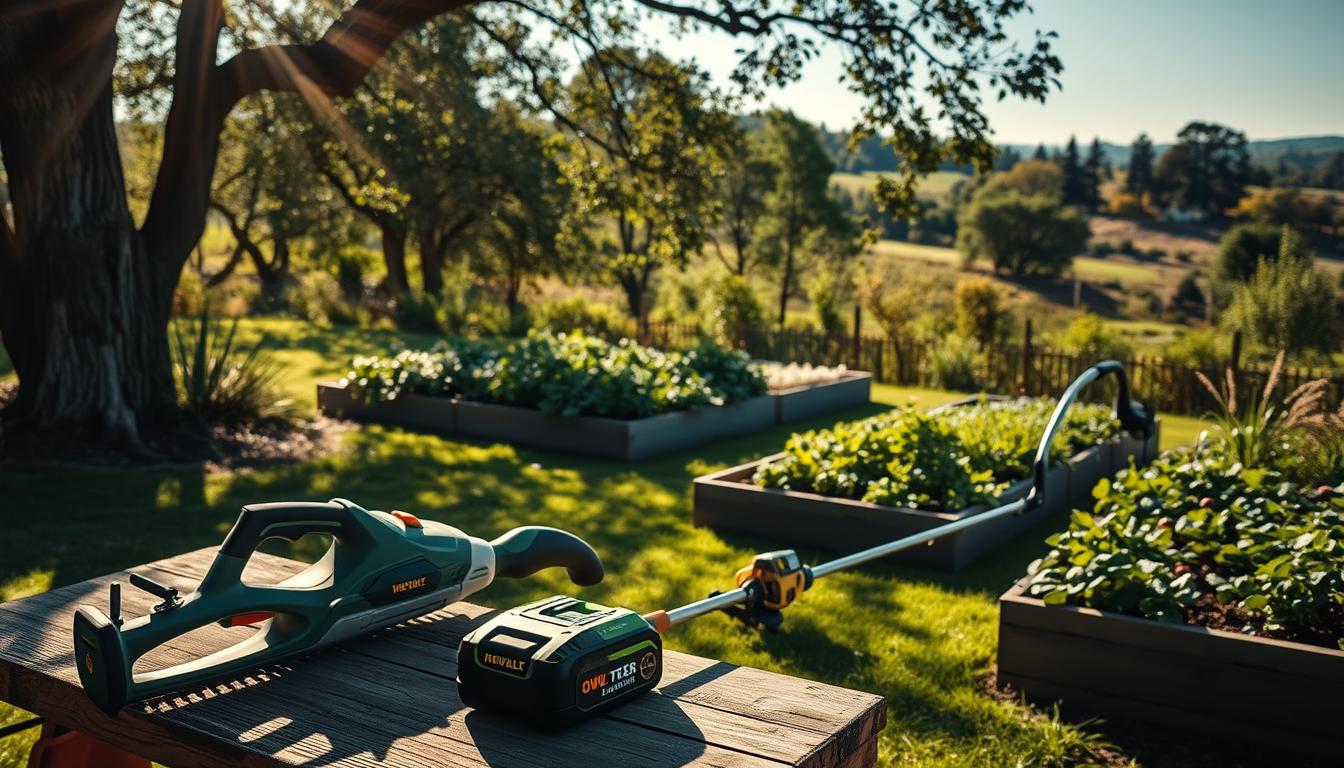The sound of gas-powered mowers and trimmers used to fill our weekends. But now, a quieter, cleaner change is happening in our gardens. More people are choosing cordless electric garden tools for their yards.
This move to eco-friendly tools is more than a trend. It’s a big step toward reducing our impact on the environment. These tools are powerful, quiet, and easy to use, without the hassle of old equipment.
New technology has made these green tools essential for homeowners. They now last longer, charge faster, and work as well as, or better than, gas-powered tools.
As we worry about air quality and noise, these tools offer a solution. They help make our neighborhoods healthier and our future greener. Plus, gardening becomes a calming activity.
The Environmental Cost of Traditional Gardening
Traditional gas-powered garden tools harm our air, water, and quality of life. Many homeowners don’t know their lawn care harms the environment. It’s important to choose sustainable tools for our outdoor spaces.
Emissions and Air Quality Impact
Gas-powered garden tools pollute the air a lot. A gas lawn mower for one hour pollutes as much as a car for 100 miles. This shows why we need cleaner yard tools.
The EPA says gas lawn equipment pollutes up to 5% of urban air. These tools release harmful chemicals that make smog. Unlike cars, they don’t have technology to reduce pollution.
These pollutants harm kids, the elderly, and those with breathing problems. Since we breathe them in, their effects are worse.
Noise Pollution in Residential Areas
Gas-powered tools are loud, like motorcycles or chainsaws. They make 90-100 decibels of noise. This can hurt our hearing over time.
Many places have rules to limit lawn tool noise. This noise also bothers wildlife, affecting their communication and breeding.
Fuel Consumption and Spills
Americans use over 800 million gallons of gasoline for lawn tools each year. This is a big waste of resources. These tools are not very efficient.
Small spills happen often when refueling. The EPA says we spill 17 million gallons of fuel yearly. This pollutes soil and water.
Switching to eco-friendly tools avoids these problems. They protect our environment and water. As technology gets better, these tools work just as well as gas ones.
Why Cordless Electric Garden Tools Are Revolutionizing Yard Care
The gardening world has seen a big change with cordless electric tools. They offer power and convenience without the hassle of cords. These tools mix old and new tech for a better gardening experience. They’re not just a trend; they’re changing how we care for our yards.
The Evolution from Gas to Electric
It all started with gas-powered tools many years ago. They were powerful but noisy, produced emissions, and needed a lot of upkeep.
Then, corded electric tools came along. They cut down on emissions and noise but tied you to a power outlet. Gardeners had to deal with cords and find outlets.
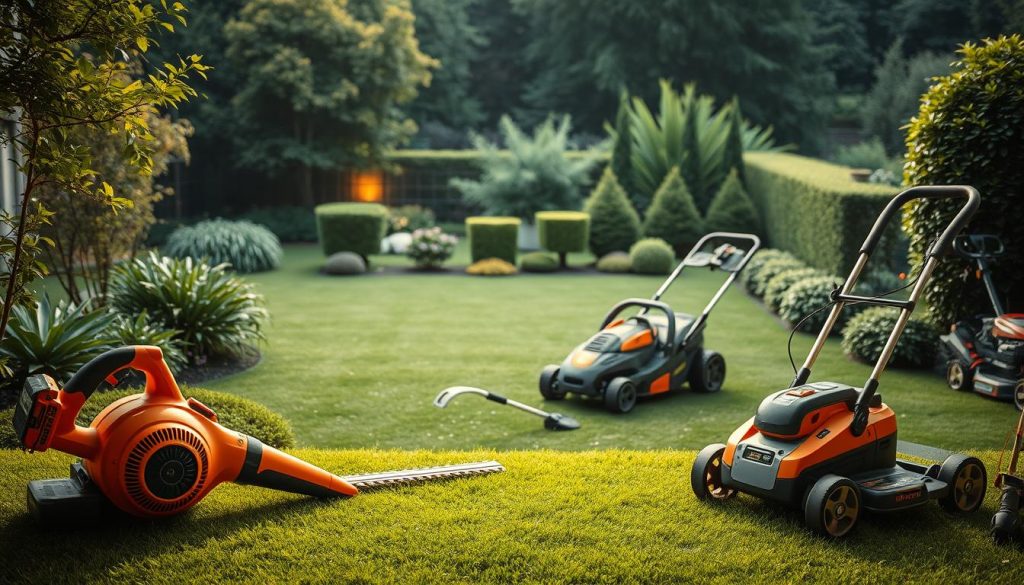
Now, we have cordless electric tools. They’ve fixed the old problems and kept the good stuff. Today’s tools are eco-friendly, easy to use, and work great.
Freedom from Cords and Outlets
Being free from cords has changed yard work. Cordless tools let you move around without worrying about outlets. No more tangled cords or extension cord mess.
This freedom is great for big yards or complex landscapes. You can work anywhere without hassle. It’s easier to get the job done.
Safety has also improved. No cords means fewer accidents. Parents like it because it’s safer for kids and pets.
Technological Advancements Driving Adoption
Several big changes have made cordless tools popular. Better batteries mean longer use and faster charging. This is thanks to lithium-ion tech.
Motor tech has also improved. Brushless motors are more powerful and use less battery. This lets cordless tools do jobs that used to need gas.
Lighter, yet strong materials have also helped. They make tools easier to use without losing durability. These changes have fixed the old problems of cordless tools.
| Tool Generation | Power Source | Mobility | Environmental Impact | Maintenance Needs |
|---|---|---|---|---|
| Gas-Powered | Gasoline/Oil Mix | High (No Cords) | High Emissions | Extensive (Filters, Spark Plugs, Fuel) |
| Corded Electric | Wall Outlet | Limited by Cord Length | No Direct Emissions | Minimal (Cord Maintenance) |
| Modern Cordless | Rechargeable Battery | Unrestricted | No Direct Emissions | Moderate (Battery Care) |
Environmental Benefits That Make a Real Difference
Modern cordless electric garden tools offer big environmental wins. They help homeowners go green, making a big difference. These tools are better for the planet than gas-powered ones, helping communities and nature.
Zero Direct Emissions During Operation
One big plus of these tools is they don’t pollute. Unlike gas tools, they don’t release harmful gases or particles. This makes them safer for our air and health.
Gas-powered lawn tools are bad for air quality. They can pollute as much as cars. A gas mower for an hour is like driving 45 miles.
- Eliminates harmful ground-level ozone production
- Prevents release of volatile organic compounds (VOCs)
- Reduces smog formation in urban and suburban areas
- Improves local air quality, specially in summer
Switching to electric tools has made air cleaner in some places. In California, air quality has improved. This is thanks to fewer gas tools being used.
Significant Noise Reduction for Neighborhoods
Electric tools are much quieter than gas ones. They’re 20-30 decibels softer. This makes a big difference in how we feel and live.
Less noise is good for animals too. It lets them live more naturally, without being scared by loud noises.
For people, quieter tools mean less stress. It also means we can enjoy our yards more. And, it’s safer for our hearing.
Reduced Carbon Footprint Over Tool Lifetime
Looking at the whole life of electric tools shows they’re good for the planet. Making batteries needs energy, but using them is cleaner. This makes them better for the environment.
A study in 2022 found electric mowers are better after 50-100 hours. For most people, that’s one to two seasons. After that, they’re even better for the planet.
Using renewable energy to charge these tools makes them even greener. This can cut down carbon emissions by up to 95%.
When lots of people use electric tools, the effect is huge. A neighborhood of 100 homes can save thousands of pounds of carbon. That’s like taking many cars off the road.
Popular Types of Cordless Electric Garden Tools
Exploring cordless electric garden tools shows a wide range of options. They help with lawn care and landscaping tasks. These tools are as good as gas models but better for the environment.
Lawn Mowers and String Trimmers
Cordless electric mowers are getting more popular. They range from small 14-inch models for small lawns to big 21-inch mowers for bigger yards. They often have features like mulching and adjustable heights.
Cordless electric trimmers are great for edging and reaching tight spots. They have adjustable cutting widths and easy line replacement.
Power Ranges and Cutting Widths
Cordless mowers have power from 36V to 80V. Lower power models are good for small yards, while higher power ones handle thicker grass. Cutting widths vary from 14 to 21 inches.
Trimmers range from 20V for light use to 60V for heavy-duty tasks. The best models have adjustable speeds for different tasks.
Runtime Expectations
Mower runtime varies with conditions and use. Most mowers run for 30-60 minutes on a charge. Some premium models can use two batteries for longer runtime.
Trimmers usually run for 30-45 minutes on a charge. They use less power when cutting thick vegetation. Many come with fast chargers that recharge in 30-60 minutes.
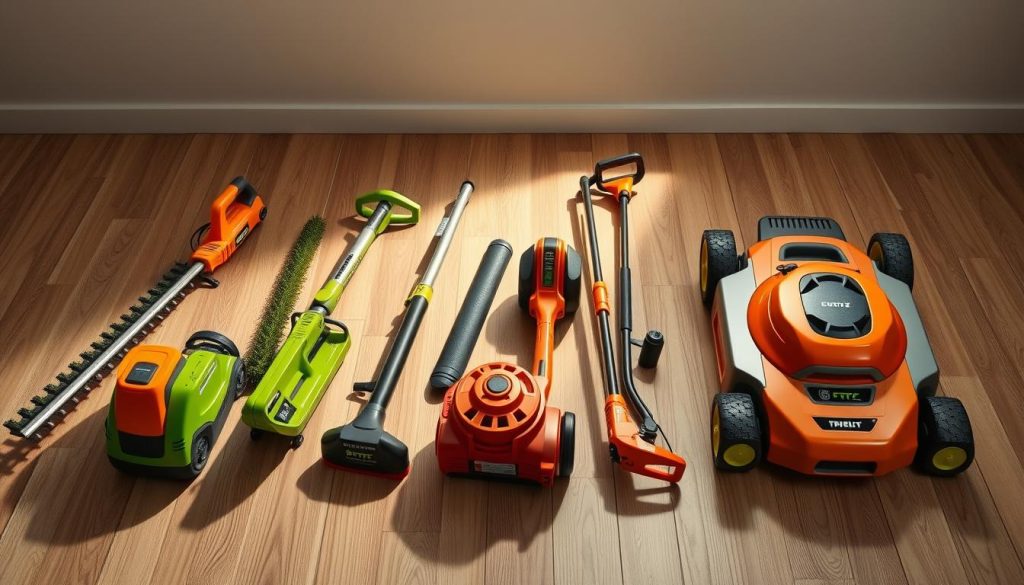
Leaf Blowers and Hedge Trimmers
Battery-powered leaf blowers have improved a lot. They range from handheld units for small jobs to backpack blowers for bigger tasks.
Cordless hedge trimmers let you shape shrubs and hedges easily. They’re quiet, making them perfect for quiet areas.
Air Volume and Cutting Capacity
Leaf blowers are rated by air volume and speed. Consumer models blow 350-600 CFM at 100-145 MPH. Professional models can blow up to 800 CFM.
Hedge trimmers have blades from 18-24 inches. The gap between the teeth determines the thickness of branches they can cut. Premium models can cut up to 3/4 inch thick.
Weight and Ergonomic Considerations
Cordless tools are lighter than gas models. Leaf blowers weigh 5-10 pounds and are designed to reduce arm fatigue. They often have variable speed triggers and cruise control.
Hedge trimmers weigh 6-9 pounds and are balanced for comfort. They have rotating handles for easy cutting and shields to deflect clippings.
Specialty Tools: Chainsaws and Cultivators
Cordless chainsaws are now useful for property maintenance. They have 40-60V power and 14-16 inch bars. They’re quiet, start instantly, and produce no emissions.
Battery-powered cultivators and tillers are great for garden bed prep. They till 6-8 inches deep and 6-10 inches wide. They’re not for breaking new ground but good for maintaining beds.
These specialty tools offer convenience and environmental benefits. They’re perfect for occasional use, balancing performance, convenience, and eco-friendliness.
Battery Technology: The Power Behind the Revolution
The real star of the cordless garden tool revolution is not what you see, but what powers it. Advanced battery technology is the key. Without this progress, today’s rechargeable outdoor power tools would still be tied to outlets or rely on fossil fuels. This change has made weekend yard work quieter and cleaner.
Modern lithium-ion yard equipment is the result of years of battery research. It has changed how we do garden maintenance. This is important for homeowners everywhere.
Lithium-Ion Advantages Over Older Technologies
The move from nickel-cadmium (NiCad) to lithium-ion batteries was a big step forward. Lithium-ion batteries pack more power in a lighter package. An 18V lithium-ion battery is half the weight of its NiCad counterpart but has more consistent power.
Lithium-ion cells don’t have a “memory effect.” This means you can recharge them anytime without losing power. This is a big difference from older battery types.
Another plus is how slowly lithium-ion batteries lose charge. NiCad batteries lose 20% of their charge in a month, but lithium-ion batteries lose only 5%. This means your tools are ready to go, even after weeks of not using them. Plus, they last longer, with many lasting 500-1000 charge cycles before losing power.
| Battery Type | Energy Density | Memory Effect | Self-Discharge Rate | Typical Lifespan |
|---|---|---|---|---|
| Lithium-Ion | High | None | 3-5% monthly | 500-1000 cycles |
| Nickel-Cadmium | Medium | Significant | 15-20% monthly | 300-500 cycles |
| Nickel-Metal Hydride | Medium-High | Minimal | 20-30% monthly | 300-500 cycles |
| Lead-Acid | Low | Minimal | 5-10% monthly | 200-300 cycles |
Voltage and Amp-Hour Ratings Explained
When you’re looking for rechargeable outdoor power tools, you’ll see two important specs: voltage and amp-hours. Knowing these helps you pick the right tool for your needs.
Voltage shows how powerful the battery is. Higher voltage means more power for tough jobs like cutting thick branches or mowing dense grass. Cordless garden tools range from 18V for light tasks to 80V for heavy-duty jobs.
Amp-hours measure how long the battery will last. To figure out how long your tool will run, use this formula: Runtime (minutes) = (Ah rating × 60) ÷ tool’s average amp draw. For example, a 4.0Ah battery in a 2 amp tool will run for about 120 minutes. Homeowner tools usually have batteries from 2.0Ah to 6.0Ah, with more for professionals.
Battery Interchangeability Between Tools
Choosing a single battery platform for cordless garden tools is smart. Big brands have systems where one battery works with many tools. This saves money and makes things easier.
Buying “bare tools” (without batteries) can save a lot. This way, you don’t need a new battery for each tool. You’ll have fewer chargers and easier battery management. Just swap batteries while one charges.
Brands like DeWalt, Milwaukee, Ryobi, and EGO have big lineups of compatible tools. Ryobi’s 18V ONE+ system, for example, has over 175 tools that use the same battery. This means you can use the same battery for garden tools and other household items, making your power system versatile for the whole home.
The Economics of Cordless Electric Garden Tools
Choosing battery-powered lawn tools is more than just good for the planet. It’s also a smart money move. Many people worry about the higher cost of electric tools compared to gas ones. But, looking at the long-term costs can help you see the real value.
Initial Investment Analysis
Electric tools usually cost more than gas ones at first. A good cordless electric mower might be $300-500. But, a gas mower could be $100-200 cheaper. This difference gets smaller for smaller tools like trimmers and blowers.
Building your electric tool set wisely is key. Start with a good battery system from a trusted brand. Then, add “bare tools” that use the same batteries. Many start with a trimmer or blower kit, then add more tools later.
Most brands offer different battery sizes for the same voltage. This lets you choose the right battery for each tool. It helps you get the most out of your money and makes your tools work together well.
Operational Savings: Fuel, Oil, and Maintenance
Electric tools save money every day. They don’t need gas, oil, or regular tune-ups like gas tools do:
- No gasoline purchases ($30-100 annually depending on property size)
- No engine oil or two-stroke oil mix ($15-25 annually)
- No spark plugs, air filters, or fuel filters ($20-40 annually)
- No carburetor cleaning or professional tune-ups ($50-100 annually)
- No fuel stabilizers for off-season storage ($10 annually)
Homeowners spend $125-275 a year on gas tools. Charging batteries for electric tools costs $5-15 a year, based on local rates.
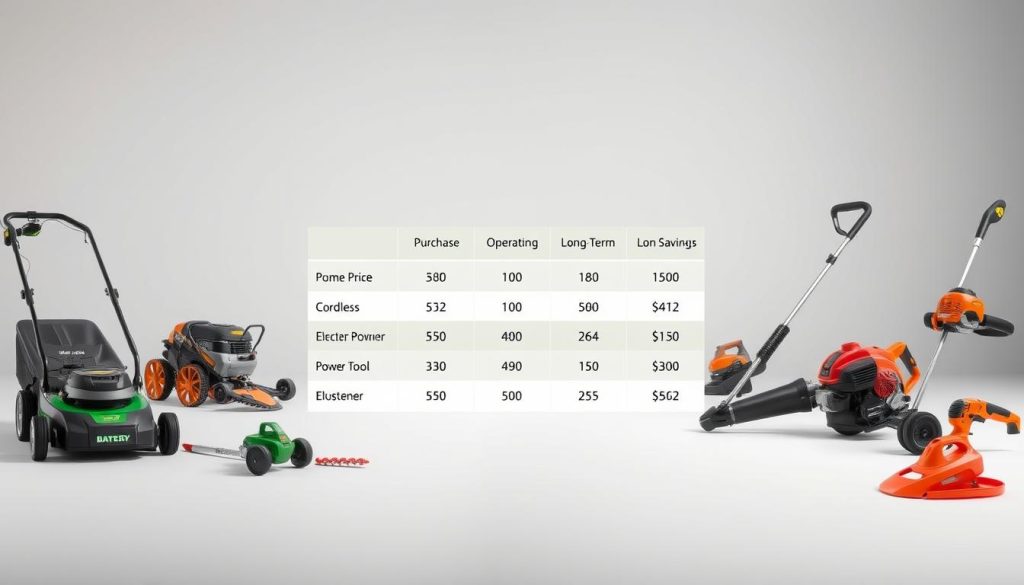
Electric tools also save time on maintenance. No more trips to the gas station or oil changes. This convenience is hard to put a price on but is very valuable for busy people.
Long-Term Cost Comparison Calculator
To figure out when electric tools pay off, use this simple guide:
First, find the price difference between electric and gas tools. For example, an electric mower might cost $450, while a gas one is $300. That’s a $150 difference.
Then, guess how much you’ll save each year. For a quarter-acre lot mowed weekly, you could save $150-200 a year. This is because electric tools use less money and need less upkeep.
In this case, the electric mower would pay for itself in the first year. Larger properties will see even quicker savings. Smaller ones might take 1-2 years.
Another thing to think about is how long the tools last. Good electric tools can last 7-10 years, needing only new batteries every 3-5 years. Gas engines often need big repairs or a new one after 5-7 years. This makes electric tools a better deal in the long run.
Performance Myths vs. Reality
The gap between gas and battery-powered lawn tools has shrunk a lot. Yet, old beliefs about cordless tools still linger. Today’s tools are much better, but knowing their real strengths and limits is key.
Power Output Comparisons
When we talk about power, gas and electric tools work differently. Gas tools use cubic centimeters or horsepower, while electric tools use voltage. This makes it hard to compare their strength.
Modern 40V and 80V tools are very powerful. They can cut through thick logs and handle dense grass. Electric motors give 100% torque right away, unlike gas engines that need to warm up.
More landscapers are using these tools every day. They show how much better they are. For most homeowners, these tools are enough for yard work.
Runtime and Coverage Area Capabilities
Battery life is a big worry for those buying gardening tools. New lithium-ion batteries last a lot longer than old ones.
Cordless mowers can cover up to half an acre on one charge. Trimmers and blowers work for 30-60 minutes. This is perfect for most suburban yards. For bigger yards, having a second battery is helpful.
How long the battery lasts depends on what you’re doing. Cutting thick grass uses more power than trimming a neat lawn. Using a blower at full speed drains the battery faster than slower settings. Knowing this helps you use your tool better.
Weather Resistance and Durability
Today’s battery tools are made for outdoor use. They have IP ratings that show how well they handle dust and water. For example, an IP54 rating means they can handle dust and water splashes.
You shouldn’t soak cordless tools in water, but they can handle rain and dew. Their sealed batteries keep out moisture. And, they’re made with materials that resist corrosion.
These tools often last longer than gas ones because they have fewer parts. With good care, they can work for 7-10 years or more.
Addressing Common Concerns About Going Electric
Switching to wireless lawn care devices raises questions about performance, how long they last, and upkeep. The benefits of cordless electric garden tools are clear, but doubts about practical use are common. Let’s tackle these concerns to help you decide if lithium-ion yard equipment is right for you.
Battery Life and Replacement Costs
Lithium-ion batteries usually last 3-5 years with regular use. Their lifespan depends on how you use and care for them. Most batteries can handle 500-1,000 charge cycles before losing a lot of power.
To keep batteries lasting longer, don’t let them drain completely before charging. Store them at 40% charge in a cool, dry place when not in use. Many users find their batteries last longer than expected with proper care.
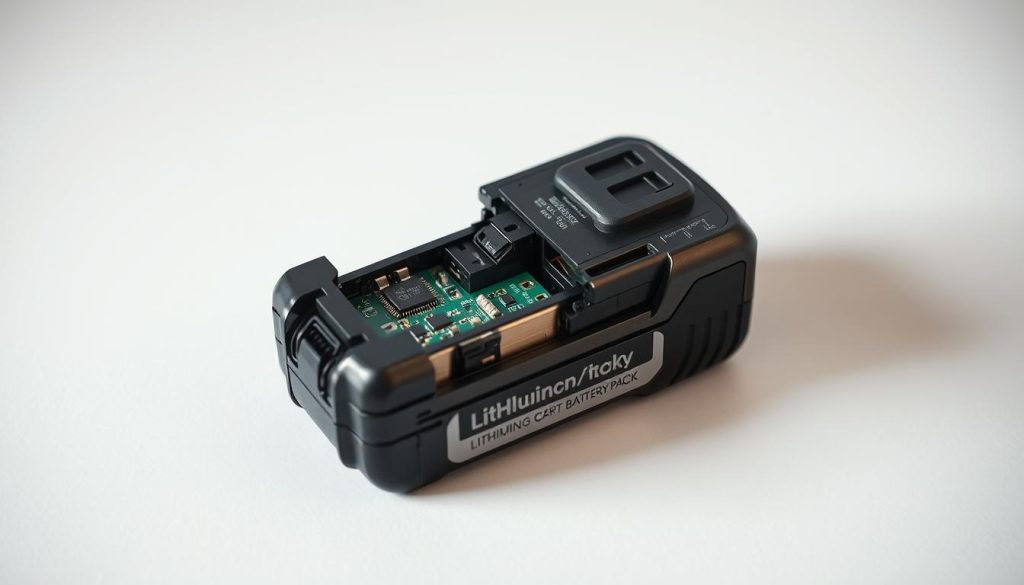
Replacement costs have dropped a lot in recent years. What used to cost $150-200 for a high-capacity battery now costs $75-125. Many makers now sell batteries separately, letting you add more tools without buying new batteries.
Power for Tough Jobs and Thick Vegetation
Many think wireless lawn care devices can’t handle tough jobs. But, modern 40V, 60V, and 80V tools are as powerful as gas-powered ones for most home needs.
High-end cordless string trimmers can cut through thick brush with the right cutting line. Electric chainsaws with 16-inch bars can handle big limbs. The key is to use them patiently and steadily, not to force through dense material.
For tough tasks, try these tips:
- Use the highest amp-hour battery for your platform
- Keep cutting edges sharp for better efficiency
- Take multiple passes for very dense vegetation
- Have a spare charged battery ready for long sessions
Availability of Parts and Repairs
As lithium-ion yard equipment grows in popularity, repair options are getting better. Most big makers have big service networks, and many local shops now fix electric tools.
Electric tools have fewer parts than gas ones, so they break down less often. When problems do happen, they usually involve:
| Component | Common Issues | Typical Solution | Average Cost |
|---|---|---|---|
| Battery | Capacity loss, charging failure | Replacement | $75-125 |
| Switch/Trigger | Intermittent operation | Component replacement | $20-40 |
| Motor | Overheating, loss of power | Repair or replacement | $50-150 |
| Circuit Board | Electrical failure | Component replacement | $40-100 |
Most makers offer 3-5 year warranties on tools and 2-3 years on batteries. While fixing electronics is different from fixing small engines, electric motors are simpler. This often means easier fixes and lower costs over time.
Creating Your Cordless Garden Tool Ecosystem
Building a good cordless garden tool collection is more than just buying tools. It’s about creating a system that fits your needs. Switching from gas to cordless tools needs careful planning. You’ll need the right tools, enough battery power, and a smooth workflow for your yard.
With a smart plan, you can make a green landscaping system. It will save you money, help the environment, and make yard work easier.
Assessing Your Property’s Specific Needs
Before buying cordless tools, think about your yard’s needs. Small yards might only need a mower and trimmer. But bigger yards might need more tools.
What grows in your yard also matters. Dense hedges, big trees, or fancy gardens need special tools. Remember, different seasons mean different tasks, like pruning in spring or mowing in summer.
Make a calendar to see how often you’ll use each tool. This helps decide if you need strong tools for long use or just basic ones for occasional jobs.
Strategic Tool Acquisition Planning
Know your needs, then plan to buy tools step by step. Start with essentials like a mower and trimmer. These tools are used a lot and help you get used to battery life.
Buy a starter kit with batteries and a charger first. Later, you can save by buying tools without batteries since you’ll have the right power sources.
Choosing tools from one brand can save money and be convenient. But, pick the best tool for the job, even if it’s from a different brand.
Look for sales and deals to spend less. Many stores offer big discounts in fall and early spring when new tools come out.
Battery and Charger Management
Good battery care is key for a smooth cordless tool experience. For most yards, having two batteries lets you work without stopping. One battery powers your tool while the other charges.
Charge your batteries regularly before yard work. Most batteries charge in 30-90 minutes. A fast charger is a good idea for long projects.
Keep batteries charged between 40-60% in a cool, dry place when not in use. Avoid very hot or cold temperatures.
Plan your yard work to use battery power wisely. Do high-energy tasks when batteries are full, then switch to easier tasks as they run low. Group similar tasks to avoid changing tools and batteries too much.
Embracing a Greener Future in Your Own Backyard
Choosing cordless electric tools over gas-powered ones makes a big difference. It’s not just about being convenient. It’s a step towards taking care of our planet.
Every time you pick an electric tool, you help make your neighborhood quieter and cleaner. These tools are a small but important change for homeowners who want to help the environment.
Using these tools is just the start. You can also reduce lawn areas, collect rainwater, or compost yard waste. Each action helps make your garden more sustainable.
New cordless garden tools are getting better all the time. Soon, they’ll have more power, last longer, and charge faster. This means they’ll work just as well as traditional tools.
You don’t have to buy everything at once. Start with the tool you use most, like a lawn mower or string trimmer. See how it makes a difference. Then, you can add more tools as you go.
Choosing eco-friendly tools is more than just yard work. It’s about making the world a better place for our kids and grandkids. Plus, you’ll enjoy gardening more, knowing you’re doing something good for the planet.

